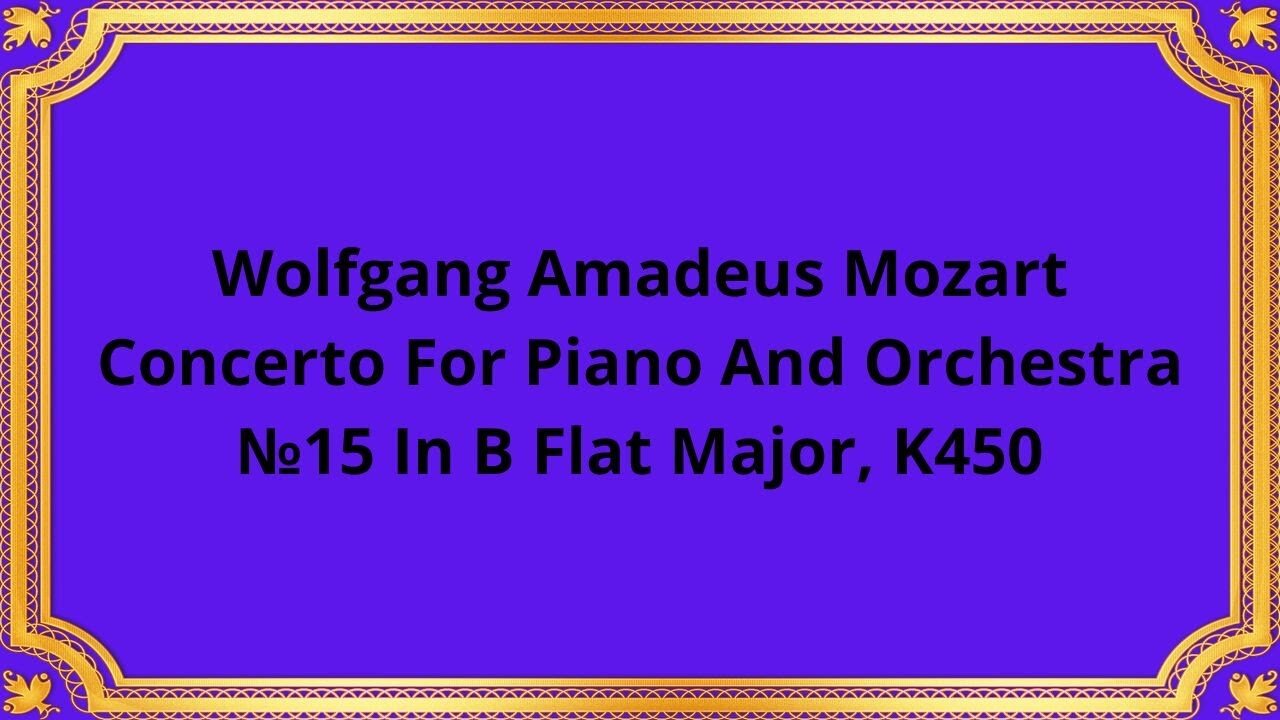Premium Only Content

Wolfgang Amadeus Mozart Concerto For Piano And Orchestra №15 In B Flat Major, K450
#WolfgangAmadeusMozart #ConcertoForPianoandOrchestra #No15 #BFlatMajor #K450 #ClassicalMusic #MusicalComposition #MozartConcerto #ClassicalComposer #ClassicalEra #ClassicalPiano
Publication date 1961
PRO MUSICA ORCHESTRA, VIENNA
Ingrid Haebler — Conductor: Heinrich Hollreiser
Wolfgang Amadeus Mozart, a name synonymous with brilliance in classical music, has gifted the world with countless masterpieces. Among his remarkable compositions, the Concerto for Piano and Orchestra No. 15 in B Flat Major, K450, stands as a testament to his musical genius.
Composed in 1784, Mozart's Concerto for Piano and Orchestra No. 15 represents the pinnacle of the Classical era. This period celebrated a shift from the Baroque style towards a more balanced and refined approach to music. Mozart was at the forefront of this movement, and this concerto exemplifies his mastery of the genre.
The concerto follows the traditional three-movement structure: Allegro, Andante, and Allegro. The first movement, marked Allegro, introduces the exuberant and lively character of the concerto. It begins with a vibrant orchestral introduction, paving the way for the solo piano to shine. Mozart's exceptional gift for melody is showcased through the interplay between the piano and the orchestra, creating a harmonious and captivating musical dialogue.
The second movement, Andante, contrasts the vivacity of the first movement with a serene and introspective atmosphere. Here, Mozart displays his ability to evoke deep emotions through his music. The piano takes center stage, weaving delicate and expressive melodies, while the orchestra provides a gentle accompaniment. The result is a mesmerizing and introspective musical journey.
The final movement, marked Allegro, brings back the energy and liveliness of the concerto. It is characterized by its playful and spirited nature, with rapid passages, virtuosic piano solos, and delightful interactions between the piano and the orchestra. Mozart's exceptional compositional skills shine through the intricate harmonies and dynamic contrasts, leaving the listener in awe of his brilliance.
Mozart's Concerto for Piano and Orchestra No. 15 is characterized by its technical brilliance, melodic richness, and inventive orchestration. The solo piano part showcases virtuosic passages, demanding precision and dexterity from the pianist. Mozart's ability to seamlessly intertwine the piano and the orchestra creates a harmonious and balanced sound, highlighting his mastery of both composition and orchestration.
Another notable feature of this concerto is Mozart's use of cadenzas. These are moments within the concerto where the soloist has the opportunity to improvise and display their own musical interpretation. These cadenzas add a personal touch to each performance, allowing the pianist to showcase their own creativity and virtuosity.
Conclusion:
Wolfgang Amadeus Mozart's Concerto for Piano and Orchestra No. 15 in B Flat Major, K450, is a testament to his musical genius and enduring legacy. Its historical significance, impeccable structure, and notable features continue to captivate audiences to this day. Through this concerto, Mozart's unparalleled talent and creativity shine, reminding us of the timeless beauty and power of classical music.
You have the opportunity to support the channel:
https://destream.net/live/RadSiarAl/donate
https://www.buymeacoffee.com/6355radsiaral
-
 2:06:30
2:06:30
Barstool Yak
6 hours agoThe Yak with Big Cat & Co. Presented by Rhoback | The Yak 11-25-24
6.36K3 -
 1:43:44
1:43:44
The Quartering
4 hours agoDr Disrespect Leaves Youtube For Rumble! With Rumble CEO Chris Pavlovski
84.5K36 -

Grant Stinchfield
2 hours agoMy Trip To The Emergency Room Exposed the Our Joke of a Health Care System
3101 -
 LIVE
LIVE
RyanMatta
1 day ago $1.01 earnedOPERATION AMBER ALERT | CHILD TRAFFICKING DOCUMENTARY | EXECUTIVE PRODUCER RYAN MATTA
476 watching -
 14:14
14:14
TimcastIRL
1 day agoJoe Rogan ROASTS The View For Saying He BELIEVES IN DRAGONS In HILARIOUS MOCKERY
42.4K76 -
 2:17:04
2:17:04
Side Scrollers Podcast
6 hours agoDoc Disrespect ON RUMBLE, PlayStation To Rival Nintendo | Side Scrollers
33.6K5 -
 12:04
12:04
Silver Dragons
3 hours agoGAME CHANGING NEWS FOR SILVER
6.06K3 -
 49:43
49:43
Ben Shapiro
3 hours agoEp. 2092 - Trump Makes His FINAL PICKS
56K39 -
 1:06:49
1:06:49
Russell Brand
5 hours agoIs Elon Musk Taking Over MSNBC?! + Trump's Executive Order Plan – SF500
139K248 -
 1:57:39
1:57:39
The Charlie Kirk Show
4 hours agoThe Fake Tulsi Smear + Is Canada a Free Country? (No) + Why Trump Is Winning | Mullin | 11.25.24
98.9K30